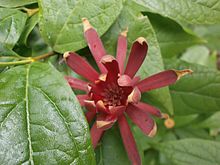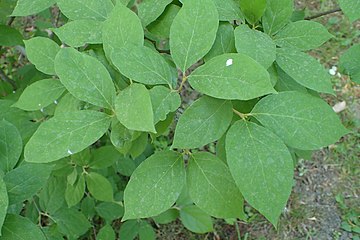Calycanthus floridus
| Calycanthus floridus | |
|---|---|

| |
| Scientific classification | |
| Kingdom: | Plantae |
| Clade: | Tracheophytes |
| Clade: | Angiosperms |
| Clade: | Magnoliids |
| Order: | Laurales |
| Family: | Calycanthaceae |
| Genus: | Calycanthus |
| Species: | C. floridus
|
| Binomial name | |
| Calycanthus floridus L.[1]
| |
Calycanthus floridus, or commonly known as the eastern sweetshrub, Carolina all spice, or spice bush,[2] is a species of flowering shrub in the family Calycanthaceae.[3] It is identifiable by its dark red flowers and fragrant scent. It is non-invasive and is found in the Southeastern United States region. The Nature Conservancy considers its conservation status to be G5, indicating it is at low risk of extinction.[4]
Description[]
Calycanthus floridus is a shrub that grows to be around 6 to 9 ft (2 to 3 m) tall.[5] Its leaves are a dark green with a pale underside. They are ovate or elliptical in shape and grow to be about 6 inches in length.[5] The leaves are simple, entire, and arranged oppositely along the stem.[6]
The flowers are solitary, featuring a reddish brown to reddish purple color when they bloom in spring. They are aromatic and so are the leaves when bruised.[5] The flowers have a hypanthium that is more than 2 cm (0.8 in) long.[7] The shape of the flowers can be cylindrical, ellipsoid, pyriform, or globose.[8] The flowers have numerous tepals that can either be oblong-elliptic or obovate-lanceolate at maturity.[8] The flowers are perfect, having both stamens and carpels on the flowers. The stamens are numerous, connective beyond the anthers.[7] The carpels are numerous. They are free, with a single ovary in a locule.[7]
The fruits are indehiscent pseudocarps that are about 8 cm (3 in) in length and 5 cm (2 in) in diameter at maturity.[7] They are formed within the receptacle and contain numerous achenes that are roughly 10 mm (0.4 in) long with a 5 mm (0.2 in) diameter.

Leaves

Flower
Taxonomy[]

Calycanthus floridus was first scientifically described by Carl Linnaeus in 1759.[1] It was the only species in his new genus Calycanthus. Linnaeus referred to an earlier illustration by Mark Catesby,[9] contained in a work published from 1731 onwards.
Distribution and habitat[]
Calycanthus floridus is native to the eastern United States.[10] It prefers sunny habitats but can tolerate moderate amounts of shade. It grows well in environments that feature moist substrate.[11]
Uses[]
It is used in horticulture as the flowers are showy and fragrant.[11] The bark of the plant is edible and is reportedly used as a substitute for cinnamon.[12] The petals of the flower are also reportedly used in tea-making.[12] Strong caution is advised however, as an alkaloid in the plant may lead to heart convulsions.[12] The viscous substance within the plant is reportedly used as a disinfectant.[12]
It is highly resistant to diseases and insects, although it is prone to infection by Agrobacterium tumefaciens, which leads to the formation of crown galls on the stems.[10][13]
References[]
- ^ Jump up to: a b "Calycanthus floridus L." International Plant Names Index (IPNI). Royal Botanic Gardens, Kew. Retrieved 2021-02-11.
- ^ "Calycanthus floridus (Bubby Bush, Carolina Allspice, Common Sweetshrub, Spicebush, Sweet Betsy, Sweet Bubby Bush, Sweetshrub, Sweet Shrub) | North Carolina Extension Gardener Plant Toolbox". plants.ces.ncsu.edu. Retrieved 2020-04-03.
- ^ "Plants Profile for Calycanthus floridus (eastern sweetshrub)". plants.usda.gov. Retrieved 2020-04-03.
- ^ "Calycanthus floridus". explorer.natureserve.org. Retrieved 2020-04-19.
- ^ Jump up to: a b c "Calycanthus floridus - Plant Finder". www.missouribotanicalgarden.org. Retrieved 2020-04-03.
- ^ "Carolina allspice". www.mortonarb.org. Retrieved 2020-04-19.
- ^ Jump up to: a b c d Radford, Albert E. (1968). Manual of the vascular flora of the Carolinas. Ahles, Harry E.,, Bell, C. Ritchie. Chapel Hill: University of North Carolina Press. ISBN 0-8078-1087-8. OCLC 355003.
- ^ Jump up to: a b "Calycanthus floridus". www.efloras.org. Retrieved 2020-04-03.
- ^ Linnaeus, C. (1759). "Calycanthus". Systema naturae per regna tria naturae, secundum classes, ordines, genera, species, cum characteribus, differentiis, synonymis, locis. II (10th ed.). Stockholm (Holmia): Salvius. p. 1066.
- ^ Jump up to: a b "Lady Bird Johnson Wildflower Center - The University of Texas at Austin". www.wildflower.org. Retrieved 2020-04-20.
- ^ Jump up to: a b "Calycanthus floridus | Landscape Plants | Oregon State University". landscapeplants.oregonstate.edu. Retrieved 2020-04-20.
- ^ Jump up to: a b c d "Calycanthus floridus, Carolina Allspice, Eastern sweetshrub, Strawberry Bush, Sweetshrub, Carolina Allspice PFAF Plant Database". pfaf.org. Retrieved 2020-04-20.
- ^ Gilman, Edward (27 May 2015). "Calycanthus floridus, Carolina Allspice, Sweetshrub". EDIS. Retrieved 2020-04-16.
- Laurales
- Flora of the United States
- Plants described in 1759

